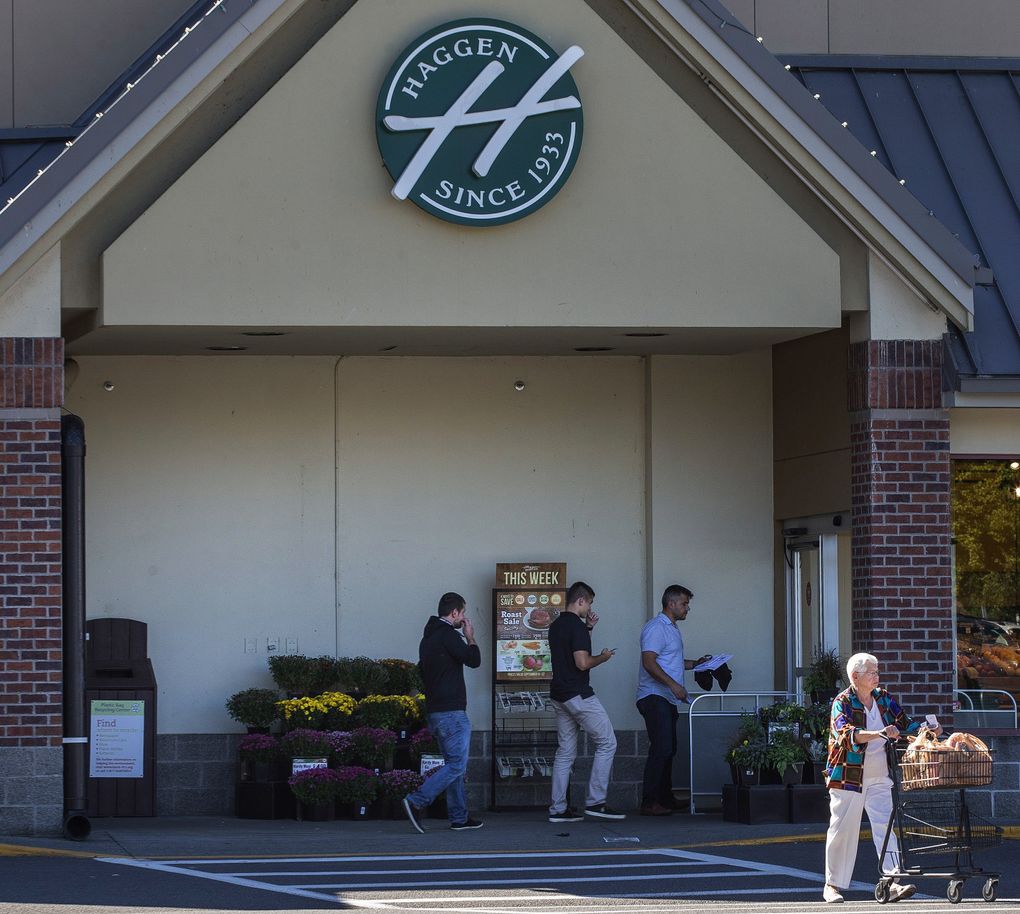Haggen plans broad retreat from costly expansion,
filing shows
Originally published September 15, 2015 at 5:26 pm Updated
September 16, 2015 at 7:32 am

Only
months after acquiring dozens of other grocery stores in the Puget Sound
region, respected grocer Haggen is seeking bankruptcy protection. The Lake
Forest Park store shown was acquired from Albertsons, whom Haggen is now suing.
(Dean Rutz/The Seattle Times)
The Bellingham grocer
expects to shed most of the sites acquired in its ambitious 146-store deal,
bankruptcy documents show.
Seattle Times business reporter
Haggen
plans to surrender most of the territory it acquired in its ambitious bid to
become a West Coast grocery powerhouse, judging by financial projections it
made in bankruptcy court that paint the Bellingham grocer shrinking to
one-third of its current size by early November.
In
a budget forecast filed in court, Haggen projects that weekly sales averaging
$44.7 million in the next two months will fall by two thirds in mid-November.
Similarly,
its expenses for grocery inventory are expected to see a similarly sharp
drop-off, from $24.5 million in the week ending Oct. 9 to $8.6 million the
following week. Payroll expenses are also projected to decrease sharply in late
October.
These
numbers underscore the dramatic and surprisingly swift retrenchment Haggen is
undertaking after failing to profitably digest many of the stores it bought
from Albertsons and Safeway in the wake of their $9.4 billion merger.
The
company has 164 stores, but even before filing for bankruptcy protection on
Sept. 8 it announced it would close 27
of them.
Haggen
declined to comment on the financial projections Tuesday. But it said last week
it would evaluate sales or closures as part of its “right-sizing strategy”
during the bankruptcy process.
In
a court filing, Haggen chief financial officer Blake Barnett said that the 17
grocery stores that were run by Haggen before its acquisition were profitable,
to the tune of $25 million in annual earnings before interest, taxes,
amortization and depreciation.
Those
locations, combined with “some” of the newly-acquired stores, will “ultimately
form a set of successful core stores” that the company will restructure itself
around, Barnett said.
Other
stores, and a portion of its pharmacy business, will be put on the block, the
filing said.
Haggen’s
court filings also make clear how much cash it was bleeding as many customers
abandoned the newly acquired stores.
Between
June 19 and Sept. 8, it tapped more than $33 million of the $36 million
available in its credit line.
Its
budget forecast for the three weeks ending Sept. 25 projects negative cash flow
totalling about $25 million.
Haggen’s
creditors committed $215 million to get the company through the bankruptcy. As
of Sept. 11, the company was estimated to have $272,000 in the bank, not
counting proceeds from the credit facility provided by the lenders after the
bankruptcy filing.
A
worker at a store in Seattle said that within 24 hours of the bankruptcy
announcement “more than 90 percent of our deliveries stopped.” But some
deliveries have started up this week, the staffer said.
In
the early weeks after the 146-store
acquisition, as it quintupled its workforce, Haggen sought to
replicate its Pacific Northwest formula of local products and organic fare in
the U.S. Southwest, one of the most competitive grocery markets in the country.
But
it didn’t go as smoothly as planned. Tina McCunney, a shopper from San Diego,
said last month that when walking into Haggen, it felt like “it’s got the kiss
of death for any retailer: very few patrons, anxious employees, a depressed
atmosphere. This is not a pleasant shopping experience,.”
Haggen
blames Albertsons for its current quagmire. Haggen sued the
behemoth grocer for $1 billion, accusing Albertsons of
sabotaging its entry into the new markets, among other things by providing
murky pricing data that Haggen says led to the high prices that turned off many
customers. Albertsons had previously sued Haggen for unpaid inventory.
The
company’s bankruptcy filing took many by surprise — including suppliers, and
the unions that represent 80 percent of its workers.
Todd
Crosby, the president of UFCW 21, which represents grocery store workers in
Washington, wrote in a message to members that employees learned about the
bankruptcy from the local news. That lack of communication was “simply wrong,”
Crosby wrote.
A
Haggen spokeswoman said the company couldn’t give workers advance notice of the
Chapter 11 filing but is “committed to communicating with our employees
throughout this restructuring period.”
It’s
unclear at this point how many stores will close, how many will be sold, and
who will end up buying them. But there are grocers trying to get into the
southern California market, including ALDI, a German chain with a strong East
Coast presence that has said it wants to open 45 stores there next year.
Nearly
11,000 jobs are at stake as the bankruptcy proceedings play out. Some 2,000
people work at the Haggen unit that oversees its original 17 stores (plus a
standalone pharmacy).
There are another 3,730 staffers in former
Albertsons and Safeway stores in Washington and Oregon, and 5,140 in
California, Nevada and Arizona, according to the filingsA short-lived behemoth
Haggen expanded its store-count ninefold as it bought 146 stores shed by Albertsons and Safeway in the wake of their $9.4 billion merger last January. It's already announced it will shed 27 stores. And now, according to bankruptcy filings, the company projects it will dispose of the majority of its young empire by early November.






No comments:
Post a Comment